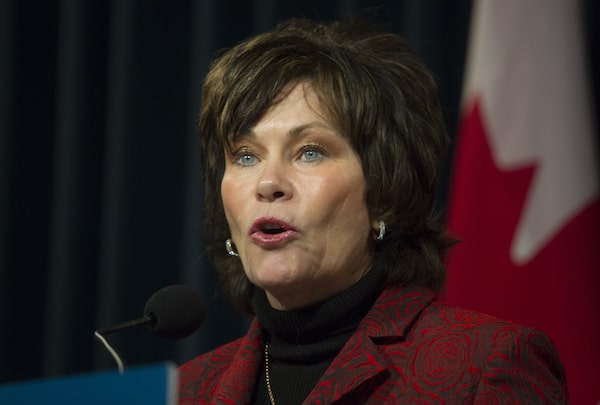
Alberta's Minister of Energy Sonya Savage said project location, Indigenous benefits, an understanding of potential interplay with other resource development activities and project readiness all factored into which projects were selected.Todd Korol/The Canadian Press
Oil sands producers are one step closer to a project they are counting on to lower their greenhouse gas emissions to zero by 2050, after the Alberta government approved a joint application for underground space to store carbon dioxide.
The government on Tuesday released a list of 19 new projects that will begin exploring how to develop carbon dioxide storage hubs to help reduce emissions across the province.
The list includes a massive oil sands CO2 storage project planned for northern Alberta by companies involved in the Pathways Alliance – an industry group that covers about 95 per cent of production in the oil sands, which has committed to get to net zero by 2050. The group includes Canadian Natural Resources Ltd., Cenovus Energy Inc., ConocoPhillips, Imperial Oil Ltd., MEG Energy Corp. and Suncor Energy Inc.
How industry is depending on carbon capture technology for climate goals
Project location, Indigenous benefits, an understanding of potential interplay with other resource development activities and project readiness all factored into which projects were selected from more than 40 applications, Alberta Energy Minister Sonya Savage said in an interview.
There are still more steps to go before any project is set in stone. Each proponent will need to sign an agreement to evaluate the suitability of their pore space (the geological formations that can store carbon), then they can apply for a sequestration agreement, which will grant companies or consortiums operating the hubs the right to inject carbon dioxide in their allotted pore space. They’ll also need to obtain regulatory approvals from the Alberta Energy Regulator and Alberta Environment and Parks.
However, Ms. Savage said granting pore space gives proponents the certainty and predictability they need to move their projects forward and look toward financing.
That’s particularly important in the case of Pathways, she said, because the group’s plan to get to net zero has “enabled a lot of conversations on energy security that we’ve been able to have outside of the country,” particularly around exporting more oil to the United States.
President of the Pathways Alliance, Kendall Dilling, said the government’s decision to send the group’s proposed carbon capture and storage hub to the next stage of evaluation was “a major milestone.”
“Engineering work is already underway on the project, including specific capture facilities in the oil sands region,” Mr. Dilling said in a statement.
“With continued collaboration with both the provincial and federal governments on a fiscal and regulatory framework that supports a practical and realistic approach to emissions reduction, Pathways Alliance companies could begin safely injecting and storing captured CO2 from several oil sands facilities by late 2026.”
Alberta’s plan is to develop a series of carbon capture, utilization and sequestration, or CCUS, hubs around the province that will capture CO2 from various emission sources, including manufacturing and energy. The projects mark the second round of applications for the province’s bounty of pore space.
“I don’t know of any place on the planet that’s ahead of Alberta in terms of moving on sequestration hubs,” she said.
“I think other jurisdictions are really interested in learning from us … so you want to be the first mover, you want to be ahead of the game, and you want to be an industry leader.”
While CCUS can be used in various major industrial sectors – such as cement, steel and fertilizer production – the oil and gas sector sees it as a key part of reducing its environmental footprint by capturing carbon-dioxide emissions and forcing them deep into the ground and out of the atmosphere.
But the latest round of allocations is more than just the oil sands and Pathways.
“When you look at all of these projects, it’s every corner of the province – north, south, Grand Prairie to Medicine Hat, Pincher Creek to Cold Lake – that really helps lower emissions in every single sector in the economy,” Ms. Savage said.
“What that also does is it attracts investment into new projects that need carbon sequestration to be able to move forward. So it’s huge for the province.”
There will likely be a third call for applications for areas without a carbon hub, or for remote carbon capture microprojects far from a hub, Ms. Savage said. The province is also evaluating how carbon-capture investments fit into Alberta’s oil and gas royalty scheme.
“There’s an expectation that there needs to be some investment from the private sector,” she said. “We want to make sure we’re competitive with the United States and with other jurisdictions, but I don’t think there’s an expectation anywhere that taxpayers pay for 100 per cent of it.”
 Emma Graney
Emma Graney